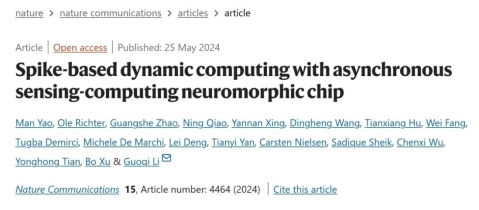Laboratory Develops Milliwatt-Level Ultra-Low-Power Asynchronous Brain-Inspired Neuromorphic Chip with Spiking Dynamic Computing
Font:【B】 【M】 【S】
The human brain can operate extremely complex and large-scale neural networks with a total power consumption of just 20 watts—far less than current artificial intelligence systems. As compute races escalate and energy consumption soars, developing new intelligent computing systems inspired by the brain’s low-power characteristics has become a highly promising direction.
Recently, the Laboratory of Brain Atlas and Brain-Inspired Intelligence at the Institute of Automation, Chinese Academy of Sciences, led by researchers Li Guoqi and Xu Bo, in collaboration with Timecho Technology and other partners, designed a brain-inspired neuromorphic System on Chip (SoC) system named Speck (Figure 1). This work demonstrates the inherent advantages of brain-inspired neuromorphic computing when integrating high-level abstractions of brain mechanisms. The related research was published online in Nature Communications.

The study introduces the concept of “neuromorphic dynamic computing,” proposing the Speck system to implement attention-based dynamic computing. At the hardware level, it achieves “no input, no power consumption,” while at the algorithmic level it enables “dynamically adjusting computation based on input importance when input exists,” reducing power consumption to as low as 0.7 milliwatts in typical visual tasks and further tapping the potential of neuromorphic computing in performance and energy efficiency.
Speck is an asynchronous, sensing-and-computing-integrated brain-inspired neuromorphic SoC. It adopts a fully asynchronous design, integrating a Dynamic Vision Sensor (DVS camera) and a brain-inspired neuromorphic chip on a single die, achieving extremely low resting power consumption (just 0.42 milliwatts). Speck can sense visual information with microsecond-level temporal resolution. Its fully asynchronous design eliminates global clock control signals, avoiding the energy overhead of clock toggling and triggering sparse addition operations only when event inputs occur.
To address the “dynamic imbalance” problem in spiking neural networks (SNNs), where they cannot adapt their spike firing in the temporal dimension to input difficulty, the study proposes an attention-based neuromorphic spiking dynamic computing framework (Figure 2). This framework enables differentiated dynamic responses to different inputs at multiple granularities. Additionally, Speck’s software toolchain, the Sinabs programming framework, supports dynamic computing SNN algorithm training and deployment. Experimental results show that attention mechanisms give SNNs dynamic computing ability, adjusting spike firing patterns according to input difficulty to solve the “dynamic imbalance” problem. This improves task performance while significantly reducing power consumption. On the DVS128 Gesture dataset, integrating spiking dynamic computing into Speck increased task accuracy by 9% while reducing average power consumption from 9.5 milliwatts to 3.8 milliwatts (Figure 3).
This work provides practical evidence that integrating high- and low-level brain mechanisms can further unleash the potential of brain-inspired computing, offering valuable insights for future efforts to incorporate diverse advanced neural mechanisms from brain evolution into neuromorphic computing.
This research was supported by the National Science Fund for Distinguished Young Scholars, Beijing Distinguished Young Scholars Fund, National Natural Science Foundation of China Key Program, and Regional Innovation Joint Key Projects.
Paper link:https://www.nature.com/articles/s41467-024-47811-6
Copyright Institute of Automation Chinese Academy of Sciences All Rights Reserved
Address: 95 Zhongguancun East Road, 100190, BEIJING, CHINA
Email:brain-ai@ia.ac.cn